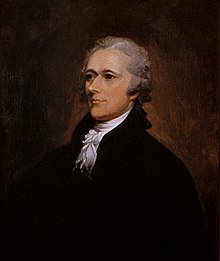Federalist Party
The term federalists is used to refer to two different groups in United States history :
- Those politicians who supported the ratification of the constitution between 1787 and 1789
- The politicians, the government policy of President George Washington and John Adams supported
The two groups overlap but are not identical.
As "Federalists" (Engl. For Federalists ) or "Federalist Party" (Federalist Party ) called at the origin that party direction which supported the American Constitution of 1787. Your name finds its equivalent in the so-called Federalist Papers or the essays summarized in The Federalist by Alexander Hamilton , who later became the first US Treasury Secretary , James Madison , who later became the 4th US President, and John Jay , who later became the first Chief Justice of the United States , who declared their republican principles there in 1787/88, establishing the need for a strong federal government.
The first group got its name because they were in favor of the signing of the constitution, which should create a closer federation between the former colonies , which were previously loosely allied . It did not form a real party, but rather a movement of people with a common goal, which dissolved again when the goal was reached.
Federalists in the second sense were the supporters of the government policy of Washington and Alexander Hamilton from 1791 onwards. B. Timothy Pickering ( Secretary of State under John Adams). These were primarily aimed at creating a strong central government, while their opponents tended to aim for a confederation that would have left power with the individual states. These federalists were not a party in the modern sense either, but they were certainly in the sense of the time.
Important points on the political agenda of the federalists were the establishment of a first national bank (which was later dissolved) to stimulate the domestic economy and the creation of an army and a fleet. The latter was used successfully in the war against North African pirates. In relation to the Revolutionary Wars in Europe, the federalists remained strictly neutral. They also called for an active economic policy in terms of manufacturing , trade and banking . In addition, they supported the interests of the craftsmen in relation to the interests of agriculture .
Personal differences between John Adams and Hamilton led to a split in the federalists and in 1800 contributed significantly to the election victory of the Democratic-Republican Party under Thomas Jefferson . The federalists remained an important party in New England for the next few years, but increasingly lost their federal influence. After Hamilton was killed in a duel with Aaron Burr and Adams retired from political life, the federalists lacked a leader and the party grew weaker and weaker.
As a proper party, the Federalists were no longer perceptible after 1815/1817 at the latest. The National Republican Party and the United States Whig Party can most likely be seen as at least partial successors to the federalists (for example, the federalist Daniel Webster was later a member of the National Republicans and then the Whigs). When it was founded in the 1850s, the Republican Party also showed certain references to the positions of the former federalists.
Federalist presidential candidates
- John Adams : 1796 , 1800
- Charles Cotesworth Pinckney : 1804 , 1808
- DeWitt Clinton : 1812
- Rufus King : 1816
See also
literature
- Felix Ermacora : The federalist . Vienna 1954
- Richard Hofstadter : The Idea of Party System. The Rise of Legitimate Opposition in the United States . 1780-1840, Berkeley, California 1970
- AW Mc Mahon (Ed.): Federalism: Mature and Emergent . New York 1955
